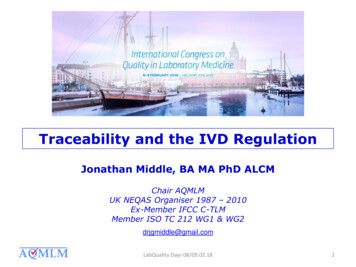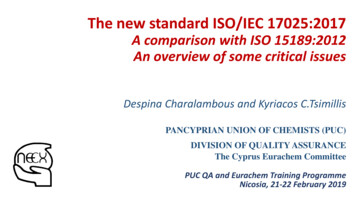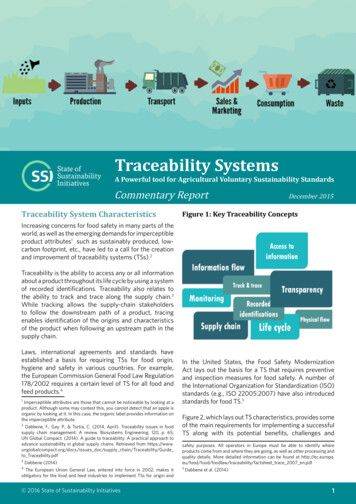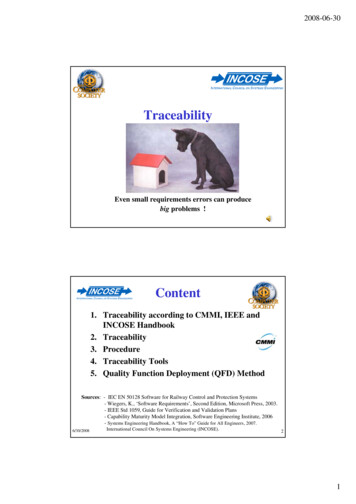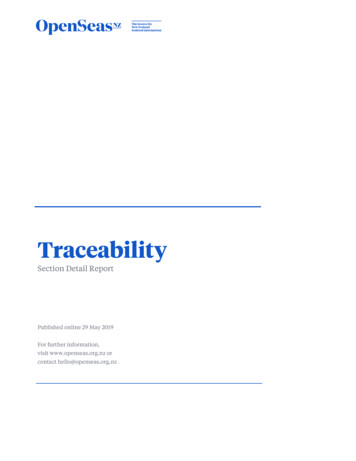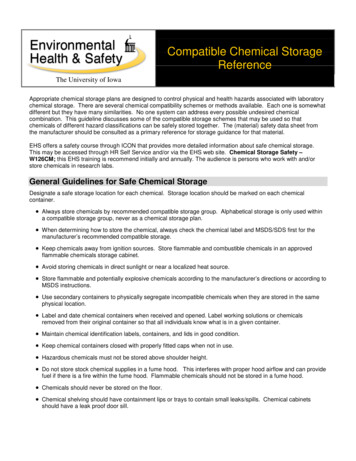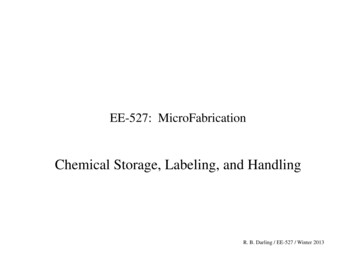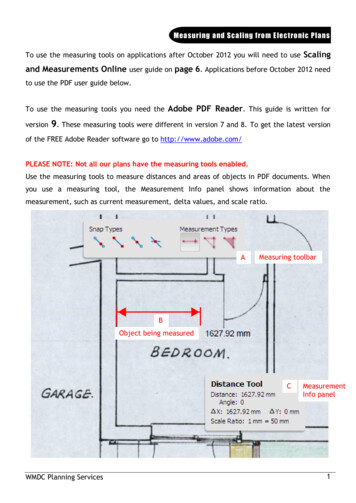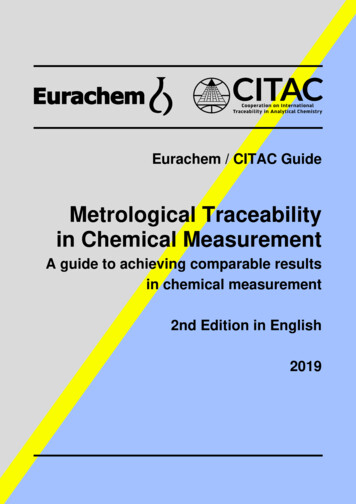
Transcription
Eurachem / CITAC GuideMetrological Traceabilityin Chemical MeasurementA guide to achieving comparable resultsin chemical measurement2nd Edition in English2019
INTENTIONALLY BLANK
Eurachem/CITAC Guide:Metrological Traceability inChemical MeasurementA guide to achieving comparableresults in chemical measurement2nd Edition in English (2019)EditorsS L R Ellison (LGC, UK)A Williams (UK)Composition of the Working Group*AcknowledgementsThis edition has been produced primarily by a jointEurachem/CITACWorkingGroupwiththecomposition shown (right). The editors are grateful toall these individuals and organisations and to otherswho have contributed comments, advice andassistance.Production of this Guide was in part supported undercontract with the UK Department for Business,Energy & Industrial Strategy as part of the Chemicaland Biological Metrology Programme.S Ellison ChairB Magnusson SecretaryR Bettencourt da SilvaW BremserA BrzyskiE ChristieR KaarlsR KausI KuselmanI LeitoO LevbargR MacarthurP Pablo MorillasF PennecchiT NaykkiP Yolcu OmerogluO PellegrinoM RössleinP RobouchE SahlinA Van der VeenM WalshW WegscheiderA WilliamsR WoodLGC, Teddington, UKTrollboken AB, SwedenUniv. Lisboa, PortugalBAM, GermanyEurachem PolandEurachem IrelandNetherlandsEurolab DE, GermanyCITACUniv Tartu, EstoniaUkrmetrteststandart, UkraineFERA, UKEUROLAB-España, SpainCITACSYKE, FinlandEurachem TR, TurkeyIPQ/DMET, PortugalEMPA St. Gallen, SwitzerlandJRC, EURISE, SwedenNMi, NetherlandsEurachem IrelandMontan Universität Leoben, AustriaUKRSC, UK*At time of document approvalCitationThis publication should be cited as follows*:S L R Ellison and A Williams (Eds) Eurachem/CITACGuide: Metrological Traceability in Analytical measurementnd(2 ed. 2019). ISBN: 978-0-948926-34-1. Available fromwww.eurachem.org.*Subject to journal requirements
Eurachem/CITAC Guide: Metrological Traceability in ChemicalMeasurementPrefaceMeasurement underpins a wide range of socio-economic activities, both domestic andinternational. Every day, thousands of chemical measurements support decisions on food safety,health and environmental protection. The global market, too, needs accurate and reliablemeasurements so that technical barriers to trade can be minimised. In all these sectors, theconcept of “tested once, accepted everywhere” is increasingly important, and the need for reliablemeasurement results that can be compared across space and time has never been greater. Reliablemeasurements depend critically on competent staff, validated and tested procedures,comprehensive quality systems, and traceability to appropriate measurement references.Recognition of these requirements is underscored by the increasing adoption of standards andmeasurement quality systems, such as laboratory accreditation against ISO/IEC 17025:2017 [1],or the pharmaceutical industry’s GLP and cGMP requirements.To achieve comparability of results over space and time, it is essential to link all the individualmeasurement results to some common, stable reference or measurement standard. Results can becompared through their relationship to that reference. This strategy of linking results to areference is termed “metrological traceability.”The International vocabulary of metrology (VIM) [2] defines metrological traceability as the:“property of a measurement result whereby the result can be related to a referencethrough a documented unbroken chain of calibrations, each contributing to themeasurement uncertainty.”This definition implies a need for effort at national and international level to provide widelyaccepted measurement standards, and at the individual laboratory level to demonstrate thenecessary links to those standards. Demonstration of appropriate metrological traceability isaccordingly a requirement of ISO/IEC 17025:2017 [1].At the international level, comparability between national measurement systems is beingcontinually improved by intercomparison of measurement standards at the National MetrologyInstitute (NMI) level. A multilateral mutual recognition arrangement was signed in 1999 by themember nations of the Metre Convention in response to the need for an open, transparent andcomprehensive scheme to give users reliable quantitative information on the comparability ofnational metrology services.Individual measurement and testing laboratories play their part by careful use of appropriatemeasurement standards and other references for calibration and control of their measurementprocesses. In an increasingly regulated environment, however, laboratories are under greaterpressure to demonstrate that their use of measurement standards (including certified referencematerials and any other references) is indeed both appropriate and sufficient.This is particularly true in analytical chemistry. Many of the physical quantities used in routinechemical measurement are underpinned by extensive and effective calibration and traceabilitysystems, making the establishment of traceability for these quantities relatively straightforward.However, the values of chemical quantities involved are typically drawn from a wide range ofreference materials and data with varying pedigree and provenance, requiring especial care andi
judgement in selection of references. Chemical measurements also typically require confirmationof identity as well as measurement of amount. Another challenge is the measurement of a speciesin complex matrices, which may influence the apparent value of the measured species. Further, itis not uncommon for useful chemical results to arise from the measurement of empiricalmeasurands, for example “extractable cadmium” (sometimes called operationally definedmeasurands). In such circumstances, it is not always so straightforward to identify therequirements for traceability, or to demonstrate that the traceability in place is adequate.The purpose of the present document is accordingly to provide guidance on identifyingtraceability requirements and establishing traceability of measurement and test results. Thedocument describes a consistent set of principles which laboratories can apply in order toestablish traceability for their measurement results, and pays particular attention to the use ofappropriate references for chemical quantities.The first edition of this Guide was issued in 2003. This second edition amends the Guide toreflect revised terminology introduced in the third edition of the VIM [2]. Detailed discussion ofthe revised VIM terminology can be found in the Eurachem Guide “Terminology in AnalyticalMeasurement: Introduction to VIM 3” [3].ii
Traceability in Chemical MeasurementContentsContentsEurachem/CITAC Guide: Metrological Traceability in Chemical MeasurementPrefaceiContents11 Scope and field of application32 Introduction33 Principles of metrological traceability63.1 Measurands, procedures and results63.2 Measurement scales, standards and units63.3 Calibration73.4 Effects on measurement results73.5 Controlling fixed conditions83.6 Controlling variables with calibration standards93.7 Common references allow arbitrary definition113.8 Role of method development113.9 Role of method validation113.10 Traceability and measurement uncertainty124 Metrological traceability: The international definition135 International system of quantities and units (SI)136 Establishing traceability156.1 Essential activities in establishing traceability156.2 Specifying the measurand and required uncertainty156.3 Choosing a suitable procedure166.4 Validation176.5 Importance of different influence quantities186.6 Choosing and applying appropriate measurement standards186.7 Uncertainty evaluation197 Choice of the reference207.1 Introduction20ECTRACE:2019.P1Page 1
Traceability in Chemical MeasurementContents7.2 Physical measurements207.3 Confirmation of identity207.4 Calibration with certified reference materials217.5 Calibration with other materials227.6 Calibration using reference data237.7 Reference materials for method development, validation and verification.237.8 Assessing the traceability of commercial reference materials238 Reporting traceability249 Conclusion25Appendix: Examples of establishing traceability26A1. Preparation of a calibration standard27A2. Cadmium release from ceramic ware31Bibliography37ECTRACE:2019.P1Page 2
Traceability in Chemical MeasurementScope and field of application1 Scope and field of application1.1 This Guide gives detailed guidance for the establishment of metrological traceability inquantitative chemical analysis, based on the definition in the International vocabulary ofmetrology (VIM) [2]. Though it is aimed principally at testing and measurement laboratoriescarrying out chemical measurement, the principles are expected to apply from routine analysis tobasic research. The document is also intended to assist laboratories in meeting the requirementson traceability of results given in ISO/IEC 17025 [1].1.2 Some common areas in which chemical measurements are needed, and in which the principlesof this Guide may be applied, are: Quality control and quality assurance in manufacturing industries; Measurement and testing for regulatory compliance; Measurement and testing utilising an agreed procedure; Calibration of standards and equipment; Measurements associated with the development and certification of reference materials; Research and development.1.3 Though this Guide discusses measurement uncertainty and method validation in relation totheir role in traceability, a detailed description is not attempted in either case. Readers arereferred to the Bibliography for additional guidance. Further details of terminology can be foundin the Eurachem Guide “Terminology in Analytical Measurement: Introduction to VIM 3” [3]and, for method validation, the Eurachem Guide “Fitness for Purpose of Analytical Methods: ALaboratory Guide to Method Validation and Related Topics” [4]. Additional references can befound in the Eurachem Reading List available at http://www.eurachem.org.1.4 Traceability is necessary but not sufficient for reliable results; other measures are necessary.It is accordingly assumed throughout this Guide that, whether carrying out measurements orassessing the performance of the measurement procedure, effective quality assurance and controlmeasures are in place to ensure that the measurement process is stable and in control. Suchmeasures normally include, for example, appropriately qualified staff, proper maintenance ofequipment and reagents, use of documented measurement procedures and control charts.Reference 6 provides further information on analytical QA procedures.2 Introduction2.1 Good analytical results are essential so that reliable decisions can be made. A key property ofgood results is comparability; the ability to compare results meaningfully wherever theyoriginate. Comparability is provided by, among other things, traceability to a consistent andagreed set of measurement units and scales. For most chemical measurement results, this is bestprovided by the SI, the internationally accepted system of units [5]. While it is recognised thatother units may be required, this Guide will generally assume that measurements will beexpressed in, or rely on, SI units.2.2 Traceability is not a new concept in chemical analysis. Before the advent of automation andinstrumental techniques, titrimetry and gravimetry were the workhorses of the chemistryECTRACE:2019.P1Page 3
Traceability in Chemical MeasurementIntroductionlaboratory and even though the average analyst may not explicitly refer to or recognise thesignificance of uncertainty or traceability, the core elements for their attainment were in place.For example, great care was, and is, paid to the preparation and calibration of volumetricsolutions, including their linkage to the SI. With more complex measurement procedures, it is notalways so straightforward to identify the requirements for traceability, or to demonstrate that thetraceability in place is adequate. The purpose of the present document is accordingly to provideguidance on identifying traceability requirements and establishing adequate traceability.2.3 There has been much discussion, both at workshops and in the literature, about the role oftraceability in chemical measurement. This document is based on the following principles, whichare fully in line with the VIM definition of traceability: Method development establishes a measurement procedure for obtaining an acceptableestimate of the value of the measurand. This measurement procedure includes an equation thatdescribes how to calculate a measurement result from other measured quantities, and specifiesthe conditions under which this equation is expected to hold; Validation demonstrates that this equation and set of conditions is sufficiently complete for thepurpose in hand.Establishing traceability ensures that the values of these measured quantities and the values of thespecified conditions are related to appropriate standards. This is achieved by calibration usingappropriate measurement standards. Calibration is essential for the critical quantities in themeasurement (see paragraph 6.5); for lesscritical values the required control may be less Box 1. Summary of basic principlesrigorous.1. We assume that an acceptable estimate y of themeasurand value can be obtained fromThese basic principles are summarised in Box1. They are discussed in detail in section 3, andrelated to the internationally accepted definitionof traceability in section 4.y f ( x1 , x 2 ,.x m )2. Validation checks that the equation above issufficient using suitable tests.Specifying the measurand, scope ofmeasurements and the targetmeasurement uncertainty [7];3. y is then considered traceable to x1 xnii) Choosing a suitable method ofestimating the value, that is, ameasurement procedure with associatedcalculation - an equation - andmeasurement conditions;iii) Demonstrating, through validation, thatthe calculation and measurementconditions include all the “influencequantities” (represented by their valuesx1 to xn in Box 1) that significantly affectECTRACE:2019.P1[1]that is, y is calculated from x1 xm using arelationship f which is valid under measurementconditions specified by xm 1 xn.2.4 This document identifies the key elementsin establishing traceability as:i)x m 1 , xm 2 . xn4. Given that Eq 1 is sufficient, all that isnecessary for complete traceability toappropriate references is that all the values x1 toxn are themselves traceable or defined values.*In practice, it is sufficient to ensure that values x1 toxn are under sufficient control to provide therequired uncertainty in y. For critical quantities, thisrequires traceable calibration against referencevalues. For less critical quantities, less stringentcontrol may be adequate.*“Defined values”: for example, unit conversion factors,mathematical constants, or the values of constants used torelate some SI units to fundamental constants.Page 4
Traceability in Chemical MeasurementIntroductionthe result, or the value assigned to a standard;iv) Identifying the relative importance of each influence quantity;v) Choosing and applying appropriate measurement standards;vi) Estimating the uncertainty.These activities are discussed individually in sections 6 and 7. Other documents in this series do,however, provide substantial additional guidance. In particular, The Eurachem/CITAC “Guide toQuality in Analytical Chemistry” [6] describes the implementation of quality systems forchemical measurement. The Eurachem Guide “The Fitness for Purpose of Analytical Methods”[4] provides detailed guidance on method validation (item iii) above), while theEurachem/CITAC Guide “Quantifying Uncertainty in Analytical Measurement” [8] describes theevaluation of measurement uncertainty in detail (item vi). In the present Guide, this detail is notrepeated, but each of these special topics is discussed briefly to identify their roles in establishingtraceability.ECTRACE:2019.P1Page 5
Traceability in Chemical MeasurementPrinciples of metrological traceability3 Principles of metrological traceability3.1 Measurands, procedures and results3.1.1 A measurand is a “quantity intended to be measured”, such as mass, volume orconcentration. It is critically important that the quantity to be measured is clearly andunambiguously defined. For example, volume is defined for a specific temperature, andconcentration applies to a particular analyte and chemical species. Some measurands are definedin terms of procedures used; for example, ‘extractable lead’ would require specification of theextraction conditions*. (Measurands defined in terms of a procedure are sometimes called‘empirical’ or ‘operationally defined’, in comparison with ‘rational’ measurands which can bedescribed without reference to a specific procedure.)3.1.2 Measurement procedures are intended to provide estimates of the values of measurands.Procedures are developed and documented so that they provide reliable estimates, and for thepurpose of this document it will be assumed that the procedure is accepted as providing anadequate estimate for the purpose in hand, and that it incorporates all necessary measurementconditions and corrections.3.1.3 Results are values ascribed to measurands following measurement of test items using anappropriate procedure. Results are accordingly estimates of measurands. Results have propertiessuch as uncertainty and, as will be shown, traceability.3.2 Measurement units and scales3.2.1 Meaningful comparisons between measurement results are only possible if the results areexpressed in the same units. This is actually achieved by quoting measurement results asmultiples of a given unit; for example, a mass of 2.1 kilograms has a mass equal to 2.1 times themass of the international kilogram. The mass of the international kilogram is the ‘unit of mass’.Clearly, in order to express one mass as a multiple of another, the two have to be compared. It isimpractical to compare all masses with the international kilogram. This comparison is thereforemost commonly indirect, through measurement standards, which are in turn calibrated againstother standards. This forms a chain of comparisons leading to the relevant primary unit or anaccepted ‘realisation’ of a unit. Providing access to consistent units of measurement by means ofmeasurement standards is the principal function of traceability; without it, there is no meaningfulmeasurement.3.2.2 A measurement scale is simply an agreed method of using units of measurement anddefining an origin (a ‘zero’ point). Mass, length and concentration are expressed using linearmeasurement scales with zero at the origin (they are ‘ratio scales’); pH, for example, is alogarithmic scale with a reference at a hydrogen ion activity of 1. When two results are describedas being ‘on the same measurement scale’ they are both expressed in the same units and using thesame origin.*Strictly, “extractable lead” is typically an abbreviation for more specific terms such as “amountconcentration .” or “mass fraction ” of extractable lead.ECTRACE:2019.P1Page 6
Traceability in Chemical MeasurementPrinciples of metrological traceability3.3 Calibration3.3.1 Section 2.4 stated that calibration is the fundamental process in establishing traceability. Itis through calibration that traceability to appropriate measurement standards is actually achievedin practice. The following paragraphs review the internationally accepted definition ofcalibration, and discuss the calibration of parts of a measurement system and of whole systems.3.3.2 Calibration is described by the VIM as the process of establishing the relationship betweenvalues shown by a measuring instrument or system, and the values provided by measurementstandards.3.3.3 Calibration can be (and usually is) applied to parts of a measurement system. In particular,instruments are normally calibrated in isolation, and then used in a larger measurement system.Items such as balances and thermometers are calibrated less frequently because they are relativelystable in the medium term; instruments such as GC or ICP equipment tend to vary much moreand are typically calibrated more frequently, often in the same run as a set of test items. For thispurpose, one would generally expect to use a pure chemical as the calibration material, though itmay be added to a matrix similar to the samples expected in order to reduce matrix effects. Underthese circumstances, the measurement standard values will appear in the calculation of the result(perhaps indirectly) and it is therefore clear that the result is traceable to these reference values.3.3.4 In some cases, calibration standards are taken through the complete measurement process.For example, a matrix reference material may be analysed at the same time as the test samplesand used to correct the results, or a known amount of material (a ‘spike’) may be used to estimateand correct for the actual analyte recovery, or other effects, during a run. Clearly, if theseprocedures are employed, either the reference material value or the amount of ‘spike’ added mustappear in the calculation for the result, perhaps via an intermediate ‘recovery factor’, and theresults are accordingly traceable to the value used.Note: This procedure implicitly assumes that spike recovery is a sufficient correction. See also the noteon spiking in section 6.4.1.3.3.5 One final situation is conceivable. It may be that during method development andvalidation, it is decided that a fixed correction should be applied to all future measurements,based on observations of a particular reference material which is not used for regular, day to daycalibration. This, too, is calibration, and since the value appears in the calculation of each result,it is meaningful to speak of traceability to the value(s) in question.Note: This should not be confused with a straightforward bias check using, say, a matrix CRM, whichdoes not generate a correction applied to results.3.3.6 Note that a calibration remains valid only so long as an instrument remains stable. Inpractice, this is assured through appropriate QC, and recalibration intervals must reflect the rateof drift.3.4 Effects on measurement results3.4.1 Any measurement can be thought of as one or more determinations combined to give aresult under specified conditions. For example, analysis of a soil sample for, say, contaminants,typically involves the quantitative determination of the mass of soil taken, and the concentrationof analyte in a measured volume of solution containing an extract from the sample. All theseparameters are qualified to some extent by the conditions of measurement. Mass is determined byECTRACE:2019.P1Page 7
Traceability in Chemical MeasurementPrinciples of metrological traceabilityweighing, either in air (“conventional mass”) or in vacuo; volume is typically taken as ‘volume at20 C’ and extraction conditions – whether for complete extraction or for a defined partialextraction - are typically defined in terms of time, solvent, and temperature. The mass,concentration and perhaps volume will of course vary from one measurement to the next, asdifferent sized samples are taken – they are the measured values of the ‘variables’ in thecalculation of the final result. The extraction and other conditions are usually held close to theirnominal values and are not expected to change; they are fixed conditions, and are not generallyincluded in the calculation.3.4.2 For a given measurement procedure, if the fixed conditions change, so will the value of theresult. For example, if extraction conditions change significantly from those specified in theprocedure, the result will be wrong, just as it would if the mass or concentration values are inerror. It follows that both the fixed conditions required for the measurement, and the othermeasured values obtained and put into the calculation of the result, affect the analytical result. Ifeither fixed conditions or variable measured quantities are incorrect, then so will be the result.These measured values, whether included in the calculation or among specified conditions, arethe values of all the ‘influence quantities’ for the measurement – all have an influence on theresult and all must be controlled. It is simplest to look first at how the fixed measurementconditions are controlled; the control of the variable parameters will be considered later.3.5 Controlling fixed conditions3.5.1 If two scientists want to get the same reading for a measurement, the simplest method is touse the same measuring instrument. To continue the soil analysis example with one simplephysical aspect of the measurement, if a consistent extraction time is important, then two analystscould simply use the same clock to determine the extraction time. If this is done, it is possible tosay that all the extraction times, and consequently the analytical results, are traceable to the timegiven by the clock; the clock provides the measurement standard of time.3.5.2 This works well, and (at least for a given procedure) is not even reliant on the clock beingcorrect. As long as the clock is consistent, if everybody involved uses the same clock and timesthe same interval (i.e. every result is traceable to the clock’s extraction time interval), everybodyinvolved will share a consistent set of conditions, and extraction timing will not cause a spread inthe results.3.5.3 This becomes unworkable very quickly if tight control is needed; it is clearly impractical forthe same clock to be used by many different scientists at different times and places. What isneeded is a collection of clocks which all show the same time. In practice, the simplest way ofachieving this is to ensure that all the clocks are themselves compared with a master clock andshown to be indicating the same interval, or corrected so that the correct interval can be deducedfrom each clock’s readings (this is ‘calibration’ against the master clock). Each analyst usingtheir own clock then generates the same extraction time. Now, it is possible to say not only thateach analyst’s results are traceable to their own clock’s interval, but also that they are allECTRACE:2019.P1Page 8
Traceability in Chemical MeasurementPrinciples of metrological traceabilitytraceable to the master clock. It is this traceability to a single measurement standard – the masterclock, in the example – that generates consistent measurement in the different laboratories.*3.5.4 This leads to one key principle: traceability to common measurement standards allows laboratories to obtain the same setof fixed conditions required for measurements.This in turn minimises variation due to changes in fixed conditions of measurement.3.5.5 The issues raised here also apply when measurement conditions are required to vary in aprescribed way. For example when a chromatography column temperature is ‘ramped’, the times,temperatures and ramp rates all fall into the category of ‘conditions of measurement’ specified bythe chosen procedure.3.6 Controlling variables with calibration standards3.6.1 Very similar principles apply when looking at the measured variables included in thecalculation of the result, but the picture is more complex since the values are not supposed to befixed, but ‘consistent’ in some way. In particular, each needs to use a consistent measurementscale. This ‘consistency’ is achieved by using the same calibration standards for successivemeasurements. The following short discussion develops this concept. For simplicity, only onereference is shown, though of course most measurements rely on several.3.6.2 Consider two laboratories, A and B, carrying out measurements on samples of broadly thesame type (see Figure 1). Each calibrates their equipment using a measurement standard with aknown nominal concentration (x1 and x2 respectively). They calculate their respective results y1and y2 from a calibration equation including the respective values of x. In each case, the result y isa function of the reference value x (usually a simple multiple, assuming a linear response). Thereference value x, of course, provides the units of measurement. Where there is such arelationship – one value is calculated from another, reference, value – the calculated value canalways be claimed to be traceable to the reference value . Here, y1 is traceable to x1, and y2 to x2,though so far that has very limited consequence.3.6.3 The important question is the relationship between y1 and y2. Though the values of y1 and y2are (usually) different, is the difference genuine, or just due to different references? Clearly, aspresented in Figure 1, there is no basis for comparing the two results; certainly we cannot write amathematical equation that would show, for example, y1 in terms of y2.*Clearly, in practice, fully calibrated clocks are rarely necessary; simple checks against a time signal aregenerally adequate for typical time intervals. But the principle is the same; all the clocks are comparedwith a single reference. To support a claim of traceability according to the VIM definition, and to be practically useful, theuncertainty associated with y also needs to be known.ECTRACE:2019.P1Page 9
Traceability in Chemical MeasurementPrinciples of metrological traceabilityFigure 1ARMTestsampleResult y1y1 f1(x1)TestsampleResult y2y2 f2(x2)x1BRMx23.6.4 If, however, the two measurement standards are both calibrated against some commonreference, a comparison becomes meaningful (Figure 2). Now, both results are derived from thesame value (x0). Both will now have the same units of measurement, (the same scale and units asx0), and direct comparison of the values y1 and y2 is now not only possible but also meaningful.By analogy, of course, x0 could also be derived from a yet higher reference to allow globalcomparisons.3.6.5 In this instance, therefore, traceability does not make the results identical; after all, fordif
3.8 Role of method development 11 3.9 Role of method validation 11 3.10 Traceability and measurement uncertainty 12 4 Metrological traceability: The international definition 13 5 International system of quantities and units (SI) 13 6 Establishing traceability 15
